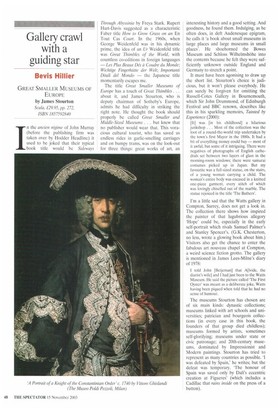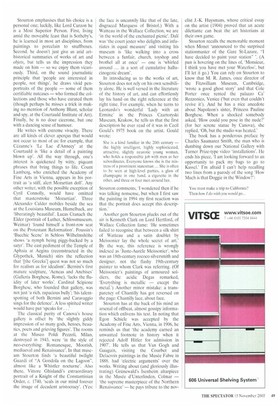Gallery crawl with a guiding star
Bevis Hillier
GREAT SMALLER MUSEUMS OF EUROPE by James Stourton Scala, 129.95, pp. 272, ISBN 1857592840 In the ancien regime of John Murray (before the publishing firm was taken over by Hodder Headline) it used to be joked that their typical book title would be Sideways
Through Abyssinia by Freya Stark. Rupert Hart-Davis suggested as a characteristic Faber title How to Grow Grass on an En Tout Cas Court. In the 1960s, when George Weidenfeld was in his dynamic prime, the idea of an Ur Weidenfeld title was Great Thimbles of the World, with countless co-editions in foreign languages — Les Plus Beaux Des ir Coudre du Monde; Wichtige Fingerhiitte der Welt; Importanti Ditali del Mondo — the Japanese title momentarily escapes me.
The title Great Smaller Museums of Europe has a touch of Great Thimbles. . . about it, and James Stourton, who is deputy chairman of Sotheby's Europe, admits he had difficulty in striking the right note. He thought the book should properly be called Great Smaller and Middle-Sized Museums. . . but knew that no publisher would wear that. This voracious cultural tourist, who has saved us endless rides in garlic-smelling carriages and on bumpy trams, was on the look-out for three things: great works of art, an interesting history and a good setting. And goodness, he found them. Indulging, as he often does, in deft Audenesque epigram, he calls it 'a book about small museums in large places and large museums in small places'. He shoehorned the Bowes Museum and Schloss Wilhelmshahe into the contents because he felt they were sufficiently unknown outside England and Germany to stretch a point.
It must have been agonising to draw up the short list. Stourton's choice is judicious, but it won't please everybody. He can surely be forgiven for omitting the Russell-Cotes Gallery in Bournemouth, which Sir John Drummond, of Edinburgh Festival and BBC renown, describes like this in his sparkling memoirs, Tainted by Experience (2000):
[It] was [in his childhood] a hilarious junkshop . . . Most of the collection was the loot of a round-the-world trip undertaken by the town's first Mayor in the 1880s. It had a bit of everything money could buy — most of it awful, but some of it intriguing. There were negatives of photographs of English cathedrals set between two layers of glass in the morning-room windows; there were samurai costumes picked up in Japan. But my favourite was a full-sized statue, on the stairs, of a young woman carrying a child. The woman's entire body was encased in a knitted one-piece garment, every stitch of which was lovingly chiselled out of the marble. The statue rejoiced in the title The Bathers'.
I'm a little sad that the Watts gallery in Compton, Surrey, does not get a look in. The collection there shows how inspired the painter of that lugubrious allegory 'Hope' could be, especially in the early self-portrait which rivals Samuel Palmer's and Stanley Spencer's. (G.K. Chesterton, no less, wrote a glowing book about him.) Visitors also get the chance to enter the fabulous art nouveau chapel at Compton, a weird science fiction grotto. The gallery is mentioned in James Lees-Milne's diary of 1978:
I told John [Betjeman] that A[Ivide, the diarist's wife] and I had just been to the Watts Museum. He said the picture called The First Oyster' was meant as a deliberate joke, Watts having been piqued when told that he had no sense of humour.
The museums Stourton has chosen are of six main kinds: dynastic collections; museums linked with art schools and universities; patrician and bourgeois collections (in every case in this book, the founders of that group died childless); museums formed by artists, sometimes self-glorifying; museums under state or civic patronage; and 20th-century museums, dominated by Impressionist and Modern paintings. Stourton has tried to represent as many countries as possible. 'I was defeated by Spain,' he writes; but the defeat was temporary. 'The honour of Spain was saved only by Dali's eccentric creation at Figueres' (which includes a Cadillac that rains inside on the press of a button).
Stourton emphasises that his choice is a personal one; luckily, like Lord Curzon he is a Most Superior Person, First, living amid the moveable feast that is Sotheby's, he is learned in most art disciplines, from paintings to porcelain to snuffboxes. Second, he doesn't just give us arid arthistorical summaries of works of art and objets, but tells us the impression they made on him — so we enjoy them vicariously. Third, on the sound journalistic principle that 'people are interested in people, not things', he draws vivid penportraits of the people — some of them certifiable nutcases — who formed the collections and those who have curated them (though perhaps he misses a trick in making no mention of Anthony Blunt, scholar and spy, at the Courtauld Institute of Art). Finally, he is no dour cicerone, but one with a dancing sense of humour.
He writes with extreme vivacity. There are all kinds of clever apergus that would not occur to most of us: for example, that Cezanne's 'Le Lac d'Annecy' at the Courtauld is 'like a detail of a painting blown up'. All the way through, one's interest is quickened by witty, piquant phrases that bring things to life. Count Lamberg, who enriched the Academy of Fine Arts in Vienna, appears in his portrait as `a stiff, alert Mozartian doll'. Any other writer, with the possible exception of Cyril Connolly, would have omitted that masterstroke 'Mozartian'. Three Alexander Calder mobiles beside the sea at the Louisiana Museum, Humelbaek, are liberatingly beautiful'. Lucas Cranach the Elder (portrait of Luther, Schlossmuseum, Weimar) 'found himself a front-row seat on the Protestant Reformation'. Poussin's `Bacchic Scene' in Schloss Wilhelmshohe shows 'a nymph being piggy-backed by a satyr'. The east pediment of the Temple of Aphaia at Aegina (reconstructed in the Glypothek, Munich) stirs the reflection that the Greeks] quest was not so much for realism as for idealism'. Bernini's first mature sculpture, 'Aeneas and Anchises' (Galleria Borghese, Rome), `lacks the fluidity of later works'. Cardinal Scipione Borghese, who founded that gallery, was not just 'a rich, rapacious bully'; 'his talentspotting of both Bernini and Caravaggio sings for the defence'. A less spirited writer would have put 'speaks for ...'
The classical purity of Canova's house gallery is offset by 'the slightly giddy impression of so many gods, heroes, beauties, poets and grieving figures'. The rooms at the Museo Poldi Pezzoli. Milan, destroyed in 1943, were `in the style of neo-everything: Romanesque, Moorish, mediaeval and Renaissance'. In that museum Stourton finds 'a beautiful twilight Guardi of "A Gondola on the Lagoon", almost like a Whistler nocturne', Also there, Vittore Ghislandi's extraordinary portrait of a Knight of the Constantinian Order, c. 1740, 'seals in our mind forever the image of decadent aristocracy'. (Yes: the face is uncannily like that of the late, disgraced Marquess of Bristol.) With a Watteau in the Wallace Collection, we are in the world of the enchanted picnic'. Dail was 'the court jester who delights and infuriates in equal measure' and visiting his museum is `like walking into a cross between a funfair, church, toyshop and brothel all at once' — one is 'whirled around in a sort of cumulative hallucinogenic dream'.
In introducing us to the works of art, Stourton does not rely on his own sensibility alone. He is well versed in the literature of the history of art, and can effortlessly lay his hand on the right reference at the right time. For example, when he turns to Leonardo's wonderful 'Lady with an Ermine' in the Princes Czartoryski Museum, Krakow, he tells us that the first description he ever read of it was in Cecil Gould's 1975 book on the artist. Gould wrote:
She is a kind familiar in the 20th century — the highly intelligent, highly sophisticated, attractive, slightly neurotic young woman, who holds a responsible job with men as her subordinates. Everyone knows she is the mistress of a prominent statesman ... She is often to he seen at high-level parties, a glass of champagne in one hand, a cigarette in the other, and three or four men around her.
Stourton comments. `I wondered then if he was talking nonsense, but when I first saw the painting in 1994 my first reaction was that the portrait does accept this description.'
Another gem Stourton plucks out of the air is Kenneth Clark on Lord Hertford, of Wallace Collection fame: 'He sometimes failed to recognise that between a silk shirt of Watteau and a satin doublet by Meissonier lay the whole secret of art.' By the way, this reference is wrongly indexed as 'Juste-Aurele Meissonier', who was an 18th-century rococo silversmith and designer, not the flashy 19th-century painter to whom Clark was referring. (Of Meissonier's paintings of armoured soldiers, the acidic Degas remarked, 'Everything is metallic — except the metal.') Another minor mistake: a transparency of Chantilly has got reversed on the page: Chantilly lace, about face.
Stourton has at the back of his mind an arsenal of offbeat, almost gossipy information which enlivens his text. In noting that Egon Schiele was accepted by the Academy of Fine Arts, Vienna, in 1906, he reminds us that `the academy earned an unwanted footnote in history when it rejected Adolf Hitler for admission in 1907'. He tells us that Van Gogh and Gauguin, visiting the Courbet and Delacroix paintings in the Musee Fabre in 1888, had 'electric arguments' over the works. Writing about (and gloriously illustrating) Grtinewald's Isenheirn altarpiece in the Musee d'Unterlinden, Colmar — 'the supreme masterpiece of the Northern Renaissance' — he pays tribute to the nov
elist J.-K. Huysmans, whose critical essay on the artist (1904) proved that an acute dilettante can beat the art historians at their own game.
Stourton recalls the memorable moment when Monet 'announced to the surprised stationmaster of the Gare St-Lazare, "I have decided to paint your station" '. (A pun is hovering on the lines of, `Monsieur, I think you have met your Waterloo', but I'll let it go.) You can rely on Stourton to know that M. R. James, once director of the Fitzwilliam Museum, Cambridge, 'wrote a good ghost story' and that Cole Porter once rented the palazzo Ca' Rezzonico, Venice (tut even that couldn't revive it'). And he has a nice anecdote about Napoleon's sister, Princess Pauline Borghese, When a shocked somebody asked, 'How could you pose in the nude?' (for her serene statue by Canova), she replied, 'Oh, but the studio was heated.'
The book has a ponderous preface by Charles Saumarez Smith, the man who is dumbing down our National Gallery with Turner Prize-type video 'installations'. He ends his piece, 'I am looking forward to an opportunity to pack my bags to go to Kassel.' I'm afraid I can't help recalling two lines from a parody of the song 'How Much is that Doggie in the Window?': You must make a trip to California? Then how I do wish you would go.



























































































 Previous page
Previous page